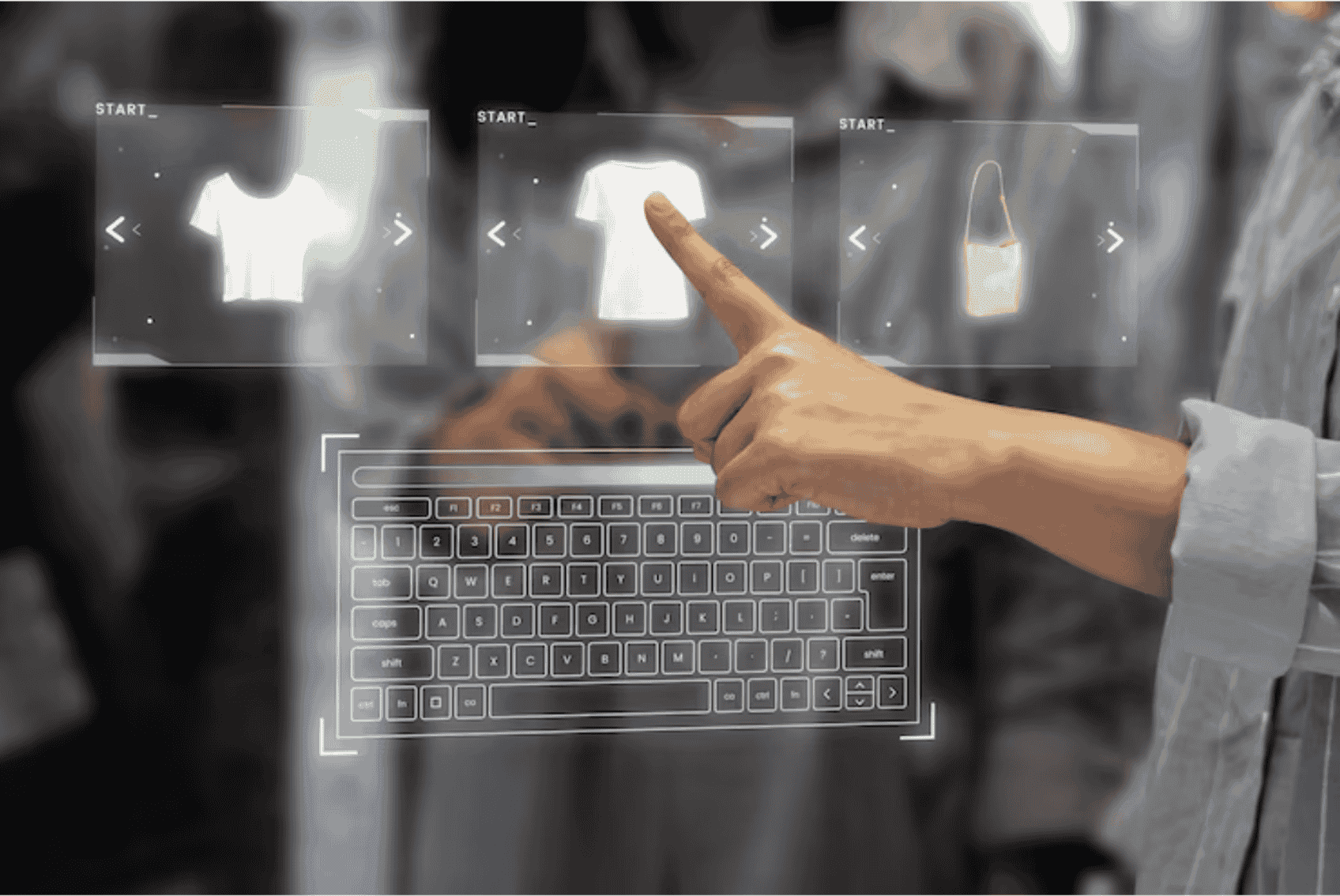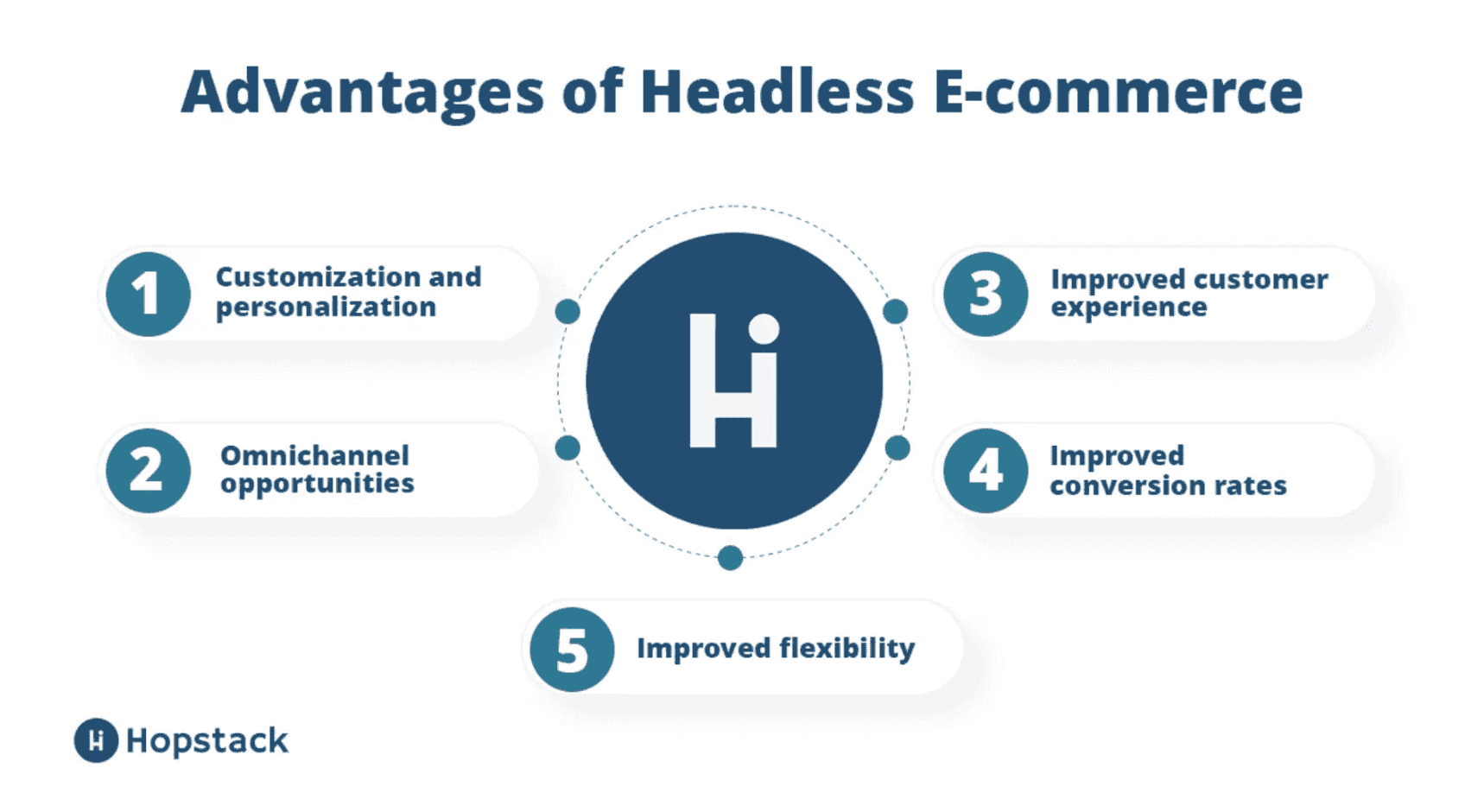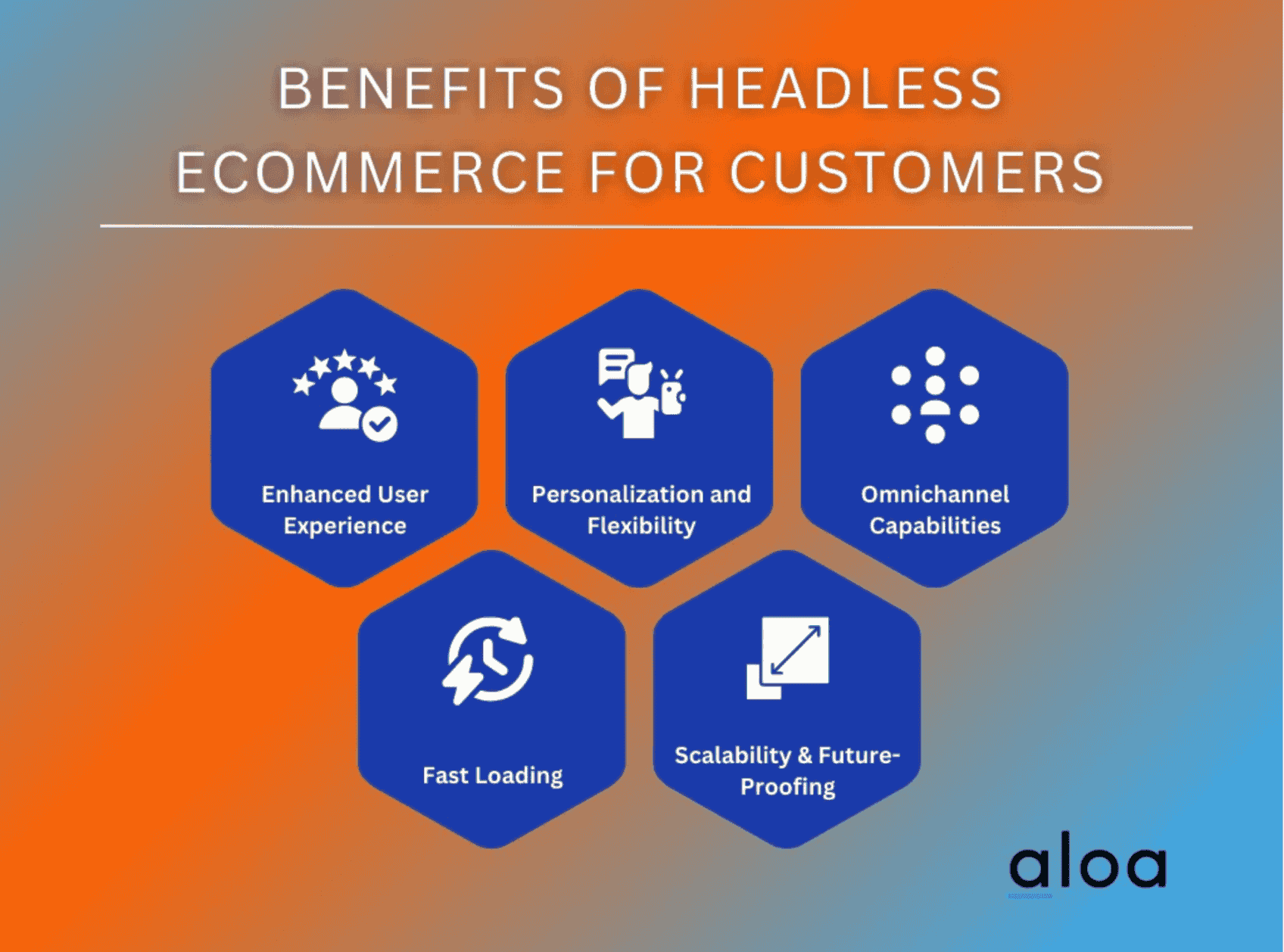The age of e-commerce has experienced a tremendous revolution since its early days in the 1990s. Basic digital stores have turned into intricate buying environments that cut across multiple devices and platforms.
Along the way, companies have always looked for mechanisms to enhance customer experience as well as boost sales and market penetration. This is where headless commerce fits in.
Headless commerce provides companies with a special liberty to build fantastic shopping experiences and yet have strong back-end functionality. Headless commerce also presents an answer that responds to these changing needs and provides companies with more flexibility and control.
Learn how headless eCommerce platforms are changing the future of eCommerce businesses.
I. Understanding Headless Commerce
Headless eCommerce architecture is one in which the front-end presentation layer (the "head") is decoupled from the back-end eCommerce functionality.
The "headless" term originates from this decoupling (the back-end system operates without a predetermined front-end), enabling companies to present content and products to any interface or device.

In this model, the back-end handles core commerce functions like:
- Product information management
- Inventory tracking
- Pricing
- Order processing
- Customer data management
- Payment processing
At the same time, the front-end may be constructed and updated independently from any technology stack that would serve the business interest.
II. Separation of Front-end and Back-end
The central technical idea in headless commerce is the communication between these split pieces. In place of direct access, they communicate using Application Programming Interfaces (APIs). These APIs play the role of messengers through which the front-end requests something specific or perform some actions at the back-end.
This API-first approach is explained here:
- Developers might utilize recent front-end technologies such as React, Vue.js, or Angular
- Front-end adjustments don't include back-end edits
- Multiple front-ends can connect to the same back-end
- Third-party eCommerce development services can easily integrate
III. Traditional vs. Headless Commerce Platforms
Traditional eCommerce websites have a monolithic architecture in which front and back-end are interdependent components of a unified system. Changes to the customer-facing portion normally need to be done to the whole system, which results in longer development time and limited flexibility.
Key differences between traditional and headless commerce include:
This fundamental architectural difference explains why many forward-thinking businesses are moving toward headless solutions as they seek greater flexibility in an increasingly multi-channel marketplace.
IV. The Driving Forces Behind Headless Commerce
Several market forces and consumer trends have accelerated the adoption of headless eCommerce platforms.
4.1. Omnichannel Shopping Experience Modern consumers don't shop exclusively through websites. They interact with brands through:
- Mobile apps
- Social media platforms
- Voice assistants
- IoT devices
- In-store digital displays
- Smartwatches & wearables
It is stated that multi-channel buyers spend 30% more than single-channel buyers on average.
4.2. Flexibility & Customization
Brands today must differentiate themselves through distinctive shopping experiences that mirror their brand. Conventional platforms tend to limit design and functionality within fixed templates and themes.
Headless commerce frees businesses from these limitations by allowing:
- Complete control over the user interface
- Custom shopping flows tailored to specific customer segments
- Unique features that differentiate from competitors
- Brand-specific interactions that strengthen identity
It’s this flexibility that also enables brands to create a lasting experience, memorable and not only creating loyalty, but improving conversion rates as well.
4.3. Quick Time-to-Market
Being first to market with new features offers you advantages. You can accelerate development using Headless eCommerce. It helps:
- Front-end developers work independently from back-end teams
- Quick testing and deployment of new features
- Agile development methodologies
- Facilitate easier A/B testing of different user experiences
When marketing teams need to launch seasonal campaigns or respond to market trends, headless architecture allows for rapid eCommerce implementation services without disrupting core business systems.
4.4. Enhanced Performance & Speed
Website loading speed directly impacts conversion rates, with studies showing that even a one-second delay can reduce conversions by up to 7%. Headless commerce improves performance by:
- Allowing for optimized front-end code without back-end constraints
- Supporting modern performance techniques like Progressive Web Apps (PWAs)
- Enabling content delivery networks (CDNs) for faster global access
- Reducing server load through API-driven eCommerce
These performance improvements translate directly to better user experiences and higher sales.
4.5. API-First Approach
Perhaps the most transformative aspect of headless commerce is its API-first philosophy. This approach means that all functionality is accessible through standardized interfaces, enabling:
- Easy integration with cutting-edge technologies
- Connection to third-party systems like ERPs and CRMs
- Implementation of microservices architecture
- Building of custom middleware for specific business needs
This interconnectedness creates a flexible ecosystem where businesses can opt for composable commerce solutions instead of being tied to just one vendor's offerings.
V. Key Benefits of Headless Commerce for eCommerce Platforms
 5.1. Improved Customer Experience
Customer experience has become the primary battleground for eCommerce success. Headless commerce improves this critical factor by enabling:
5.1. Improved Customer Experience
Customer experience has become the primary battleground for eCommerce success. Headless commerce improves this critical factor by enabling:
- Faster page loads and transitions
- Consistent experiences across all devices
- Personalized content and product recommendations
- Custom checkout processes optimized for conversion
- Rich, interactive features that engage customers
Such enhancements deliver lower cart abandonment rates as well as higher customer satisfaction and loyalty.
5.2. Better Scalability & Agility
Business needs change rapidly, especially in eCommerce. Headless commerce provides the scalability and agility to:
- Handle traffic spikes during peak seasons
- Expand into new markets without rebuilding the entire platform
- Add new product categories or business models
- Swiftly respond to changing consumer tastes
- Compete at the speed of innovation
This flexibility is especially important for businesses that are expanding and require their technology to expand at the same rate.
5.3. Seamlessly Work with New Technologies
Headless commerce positions businesses to quickly adopt new technologies like:
- Augmented reality for product visualization
- Voice commerce through smart speakers
- Artificial intelligence for personalized shopping
- Connected Shopper Experience with IoT (Internet of Things)
These organisations should consider mobile-first progressive web apps. Unbundling the front-end from the back-end lets companies experiment with these technologies without changing their core commerce systems.
5.4. Enhanced Stability & Security
These are nightmares to an eCommerce business when security breaches and system crash.
- Reduced attack surface through decentralized architecture
- Ability to update security features without disrupting the customer experience
- Better isolation of sensitive customer and payment data
- More robust testing capabilities across system components
- Easier compliance with regional data protection regulations
These security benefits help protect both business operations and customer trust.
VI. Real-World Use Cases & Industry Adoption
 6.1. Successful Brands Utilizing Headless Commerce
6.1. Successful Brands Utilizing Headless Commerce
Nike went headless to harmonize Omni-channel shopping experience on their website, mobile app and in-store digital screens. This gambit led to a surge in mobile engagement. Amazon has long used headless principles to power their vast ecosystem of shopping experiences, from their main website to Alexa voice shopping, Amazon Go stores, and various mobile apps. This architecture allows them to experiment with new shopping models rapidly. Tesla uses headless commerce to create a unique car-buying experience that differs dramatically from traditional dealership models. Their system integrates the online configuration and purchasing process with their custom-built CRM and vehicle management systems.
6.2. How Different Industries Benefit
- Retail: Fashion and apparel retailers use headless commerce to create visually rich experiences with features like virtual try-on, lookbooks, and social shopping integration.
- B2B Sector: Manufacturers and wholesalers implement headless solutions to create custom portals with complex pricing structures, account hierarchies, and integration with procurement systems.
- Healthcare: Medical suppliers use headless commerce to build compliant storefronts that connect with health records systems while providing simplified purchasing experiences.
- Subscription Services: Companies offering subscription products benefit from headless commerce by creating seamless subscription management interfaces across web and mobile platforms.
6.3. Case Study Analysis
One mid-sized fashion retailer switched to a headless approach when expanding internationally. Their previous platform couldn't handle multiple currencies, languages, and regional tax structures without creating separate stores for each market.
After implementing a headless solution:
- They reduced page load times by 60%
- Mobile conversion rates increased by 15%
- New market launches now take weeks instead of months
- Development cycles for new features decreased from months to days
- Total cost of ownership decreased despite initial implementation costs
This case demonstrates how headless commerce can solve specific business challenges while providing long-term operational benefits.
VII. Challenges and Considerations

While the benefits are compelling, businesses should understand the potential challenges of adopting headless eCommerce platforms.
7.1. Higher Initial Investment & Complexity
Implementing headless commerce typically requires:
- More specialized development talent
- Higher initial development costs
- Greater technical planning and architecture design
- More complex project management across teams
- Potential digital consulting services for strategic guidance
Organizations must carefully weigh these upfront investments against long-term benefits and total cost of ownership.
7.2. Ongoing Maintenance & API Management
Running a headless commerce system introduces specific operational considerations:
- API governance and version management
- Performance monitoring across decoupled systems
- Multiple codebases to maintain and update
- More complex testing requirements
- Deploy eCommerce maintenance & support solutions
- Need for strong documentation and knowledge management
Businesses should establish clear processes for handling these ongoing tasks to ensure system stability.
7.3. Potential Learning Curve for Traditional Businesses
Organizations accustomed to all-in-one eCommerce platforms may face adjustment challenges:
- Team restructuring around new technology needs
- New workflows between marketing and development teams
- Different metrics for measuring system performance
- Shifted to headless CMS for eCommerce
- Need for cross-functional collaboration
This cultural shift often requires deliberate change management strategies alongside technical implementation.
VIII. The Future of Headless Commerce in eCommerce
8.1. Market Potential and Trends
 The headless commerce market is projected to grow at a CAGR of nearly 22% during the forecast period. This growth is being fueled by:
The headless commerce market is projected to grow at a CAGR of nearly 22% during the forecast period. This growth is being fueled by:
- Increasing consumer expectations for seamless omnichannel experiences
- Growing adoption of mobile and IoT shopping
- Rising demand for personalized shopping journeys
- Expansion of direct-to-consumer business models
- Need for greater business agility in volatile markets
As more success stories emerge, we can expect accelerated adoption across retail segments.
8.2. AI and Machine Learning Enhancement
The combination of headless architecture with AI capabilities will create even more powerful commerce experiences:
- Hyper-personalization based on real-time behavior
- Dynamic pricing optimized for conversion
- Predictive inventory management
- Automated content creation and optimization
- Voice and visual search integration
These AI-powered capabilities will be easier to implement in headless systems due to their open architecture and API accessibility.
8.3. Shift Towards Composable Commerce
The next evolution beyond basic headless architecture is composable commerce where businesses assemble their perfect commerce stack from specialized microservices. This approach allows:
- Selection of best-of-breed components for each function
- Replacement of individual services without system-wide changes
- Faster innovation through specialized service providers
- Greater cost efficiency by paying only for needed capabilities
- Reduced vendor lock-in
This composable future represents an even more flexible model than current headless implementations.
8.4. No-Code/Low-Code Headless Solutions
To address the complexity challenges, we're seeing the emergence of tools that make headless commerce more accessible:
- Visual front-end builders that connect to headless back-ends
- Pre-built component libraries for common commerce functions
- Simplified API management interfaces
- Templated starter kits for various industry needs
- Integration marketplaces with pre-built connectors
These tools will help smaller businesses adopt headless approaches without requiring extensive development resources.
IX. How Businesses Can Prepare
Organizations considering a move to headless commerce should:
- Audit their current customer journey across all touchpoints
- Identify pain points in their existing commerce architecture
- Assess their team's technical capabilities and knowledge gaps
- Start with small proof-of-concept projects to build experience
- Consider a phased migration approach rather than complete replacement
This measured approach helps minimize risks while building organizational capabilities for headless commerce success.
Conclusion
Headless commerce represents a fundamental shift in how eCommerce platforms are built and operated. By separating the front-end customer experience from back-end commerce functions, businesses gain more flexibility, performance, and scalability.
While implementing headless commerce requires careful planning and potentially higher initial investment, the long-term benefits like improved customer experiences, better business agility, easier technology integration, and stronger security, make it an increasingly attractive option.
The question for most businesses is no longer whether to adopt headless commerce, but how to begin transitioning to this more adaptable and future-proof architecture. So, connect with top eCommerce consulting services providers to get your next project done smoothly.
Read more:
